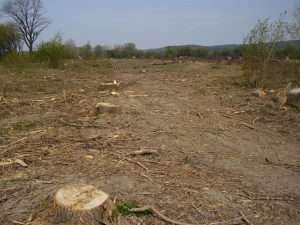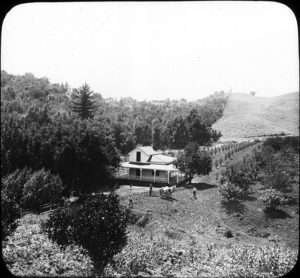 One of the most traumatic and formative experiences of my life occurred when I was thirteen years old. The woods that I loved exploring behind our yard were completely bulldozed one day; I discovered this when I got off the bus from school. It was part of the destruction of an entire wild area that would become yet another subdivision devoid of trees and vines and wildflowers, with no place left for bobwhite quail or garter snakes in the flat green lawns. I was devastated, and in an attempt to try to help me my mom chatted with the developer when she happened to run into her in town. “She knows how you feel,” my mom said. “Her woods were the ones that were torn down to make the junior high track.” Not only did it just not make sense to me that someone who had been through what I was experiencing would then go on to do the same horrible acts, but it was also my first introduction to the reality of environmental generational amnesia.
One of the most traumatic and formative experiences of my life occurred when I was thirteen years old. The woods that I loved exploring behind our yard were completely bulldozed one day; I discovered this when I got off the bus from school. It was part of the destruction of an entire wild area that would become yet another subdivision devoid of trees and vines and wildflowers, with no place left for bobwhite quail or garter snakes in the flat green lawns. I was devastated, and in an attempt to try to help me my mom chatted with the developer when she happened to run into her in town. “She knows how you feel,” my mom said. “Her woods were the ones that were torn down to make the junior high track.” Not only did it just not make sense to me that someone who had been through what I was experiencing would then go on to do the same horrible acts, but it was also my first introduction to the reality of environmental generational amnesia.
Defining Environmental Generational Amnesia
The term was coined a few years ago in a paper by Peter Kahn and Thea Weiss. It refers to how each generation considers how it first experienced a place as its true baseline, and any change that comes after it is abnormal or unnatural. So for me, the track at my junior high with just a line of trees along the creek was my understanding of its baseline, but the developer remembered that land as acres of woods. A hundred years ago it may have been a farm. Go back several generations to when only the Osage lived here, and it was probably undamaged oak savanna, or perhaps a tallgrass prairie.
When you multiply that shifting understanding of the “normal” state of a place by all the people in a given area, something is bound to be lost as generations die off, and new ones are born into the present state. Couple that with a serious lack of nature literacy, and you have fewer people discussing what the place is versus what it once was.
In cases where almost all the land has been significantly changed by human activity for centuries, it can be incredibly challenging to piece together what it was like before we came through and wrought such imbalances. The only evidence may remain in a few remote undamaged patches, scraps of partial plant and animal communities, and oral and written information passed down by people, whether indigenous or colonizing. Sometimes ecologists and other scientists need to look at the ecosystems of neighboring areas to get some idea of what might have been here before. It’s often a matter of trying to piece together an incomplete puzzle, giving best educated guesses as to what filled the empty niches.
Why is Environmental Generational Amnesia a Problem?
 If you have a population that has a dim memory at best of what a place looked like before it was changed at all, they’re less likely to understand when there’s a problem. I knew, for example, that it was wrong to tear down the woods behind my home, but my baseline was “mix of trees and shrubs of various species surrounding a creek with a limestone bed next to a twenty year old subdivision.” No one could tell me what that farm looked like before it became a farm, and I didn’t understand at the time that the mix of plants and animals I knew and loved were neither the complete original assortment, nor were they all native. How was I to know that my yard was once spacious grassland, dotted with white oak here and there? How should I have come to understand that the woods I had cherished were badly out of ecological balance compared to what had once been, that they were exhibiting signs of recolonization after multiple massive disturbances before I was even born?
If you have a population that has a dim memory at best of what a place looked like before it was changed at all, they’re less likely to understand when there’s a problem. I knew, for example, that it was wrong to tear down the woods behind my home, but my baseline was “mix of trees and shrubs of various species surrounding a creek with a limestone bed next to a twenty year old subdivision.” No one could tell me what that farm looked like before it became a farm, and I didn’t understand at the time that the mix of plants and animals I knew and loved were neither the complete original assortment, nor were they all native. How was I to know that my yard was once spacious grassland, dotted with white oak here and there? How should I have come to understand that the woods I had cherished were badly out of ecological balance compared to what had once been, that they were exhibiting signs of recolonization after multiple massive disturbances before I was even born?
And this is just one example of one person’s understanding of one place. This environmental generational amnesia has rippling effects worldwide, with people not understanding that the rivers nearby aren’t supposed to be as stick-straight as they are, that the coastline should be covered in wetlands rather than open sand, that the dense forest is only there because natural fires were suppressed and allowed the trees to take over the last meadows. There are even those who have no idea that their air, water, and soil aren’t supposed to be loaded with pollutants, because pollution is all they’ve known for generations. It’s tough to imagine an extinct wetland when you can’t even see the water for the trash, and the sky is brown instead of blue.
So What Can We Do?
It’s not going to be an easy task to try to revive the collective memory of Lands That Were. A good starting point is to talk to our elders, both alive and dead. When we ask those who still live what they remember of a place, we can glean important details even if they themselves weren’t ecologists, or formal scientists of any other sort. If we can take them to these places and have them show us where important landmarks were and describe what has changed, we can start to see more clearly what’s been lost. And when we read the writings and view the landscape art of those who are long passed, we get important snapshots of what was there long before any of us today were alive, tracing that ecological story closer to its origin.
 We also need, more than ever, to preserve what ancient ecosystems still remain, whether that’s old growth forests, or prairies that never knew the tearing of the plow, or wetlands never drained or polluted. We can’t just miraculously replace them in a matter of a few years, and they offer us crucial pictures of the end goal in places where we are attempting long-term habitat restoration. They are living, breathing records of what places looked like before, of the biodiversity and other natural structures that were in place for thousands of years.
We also need, more than ever, to preserve what ancient ecosystems still remain, whether that’s old growth forests, or prairies that never knew the tearing of the plow, or wetlands never drained or polluted. We can’t just miraculously replace them in a matter of a few years, and they offer us crucial pictures of the end goal in places where we are attempting long-term habitat restoration. They are living, breathing records of what places looked like before, of the biodiversity and other natural structures that were in place for thousands of years.
Finally, we need to be talking openly about the disconnect between what is and what was. If I, as an incredibly nature-obsessed kid, was startled to think about how my “normal” was only a faint shadow of past ecological glory, then imagine how jarring it must be for someone who is further removed from nature to understand that the forest they walk through is really supposed to be a prairie. (Especially after many years of being told that “planting trees” is the answer to all the ecological problems we face!)
With time and education we can bring about awareness, and that awareness will help us make better decisions for the future. There are so many people who want to undo ecological destruction and make the world a better place; we just need to have better, more accurate information out there on what can be reasonably done. Much of that hinges on having a clearer idea of what’s been lost, so that we can make plans to save whatever is left, and restore as much as we can.
